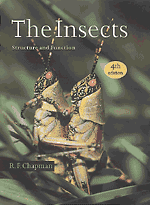Book contents
- Frontmatter
- Contents
- Preface
- Acknowledgments
- PART I The Head, Ingestion, Utilization and Distribution of Food
- PART II The Thorax and Locomotion
- 7 Thorax
- 8 Legs and locomotion
- 9 Wings and flight
- 10 Muscles
- PART III The Abdomen, Reproduction and Development
- PART IV The Integument, Gas Exchange and Homeostasis
- PART V Communication
- Taxonomic index
- Subject index
7 - Thorax
Published online by Cambridge University Press: 05 June 2012
- Frontmatter
- Contents
- Preface
- Acknowledgments
- PART I The Head, Ingestion, Utilization and Distribution of Food
- PART II The Thorax and Locomotion
- 7 Thorax
- 8 Legs and locomotion
- 9 Wings and flight
- 10 Muscles
- PART III The Abdomen, Reproduction and Development
- PART IV The Integument, Gas Exchange and Homeostasis
- PART V Communication
- Taxonomic index
- Subject index
Summary
The skeleton of the thoracic segments is modified to give efficient support for the legs and wings, and the musculature is adapted to produce the movements of these appendages.
SEGMENTATION
In larval holometabolous insects the cuticle is soft and flexible, or only partially sclerotized, and the longitudinal muscles are attached to the intersegmental folds (Fig. 7.1a). This represents a primitive condition comparable with that occurring in the annelids. Insects with this arrangement move as a result of successive changes in the shapes of the thoracic and abdominal segments (section 8.4.3), these changes of shape being permitted by the flexible cuticle. When the cuticle is sclerotized, sclerites in the intersegmental folds which have the longitudinal muscles attached to them are usually fused with the segmental sclerites behind. The large sclerite on the dorsal surface of a segment is called the tergum, or, in the thorax, the notum. Anteriorly it incorporates the intersegmental region, the original fold being marked by the antecostal sulcus where the cuticle is inflected. The narrow rim in front of the sulcus is called the acrotergite (Figs. 7.1b, 7.2). An acrotergite never occurs at the front of the prothorax because the anterior part of this segment forms part of the neck and the muscles from the head pass directly to the acrotergite of the mesothorax.
An area at the back of each segment remains membranous, forming a new intersegmental membrane. This does not correspond with the original intersegmental groove and so a secondary segmentation is superimposed on the first, but neither corresponds precisely with the ‘parasegments’ defined by molecular studies (see section 14.2.5).
Information
- Type
- Chapter
- Information
- The InsectsStructure and Function, pp. 144 - 150Publisher: Cambridge University PressPrint publication year: 1998
